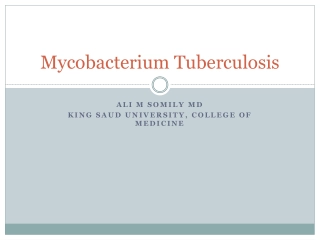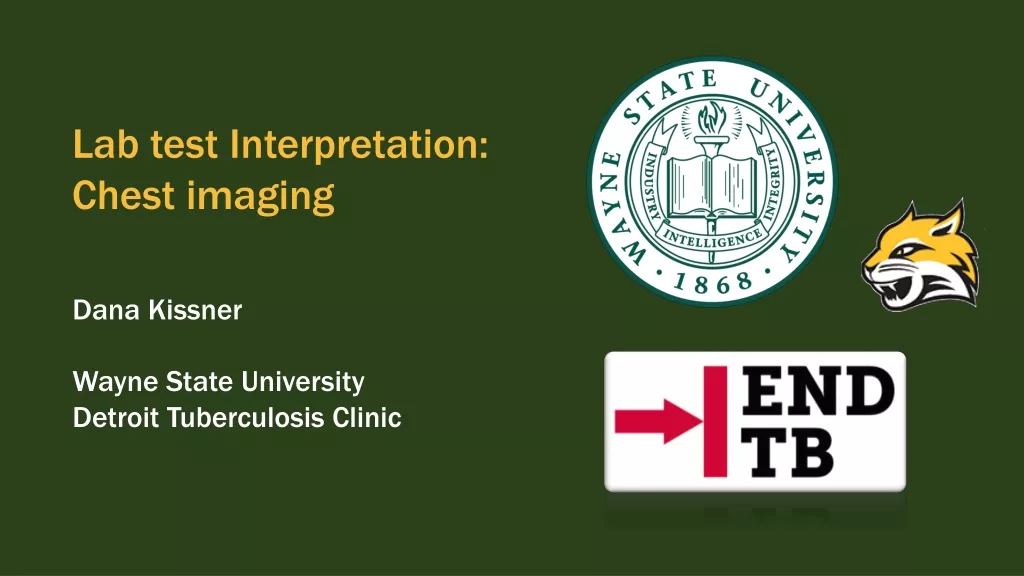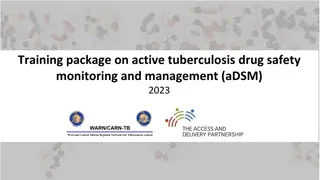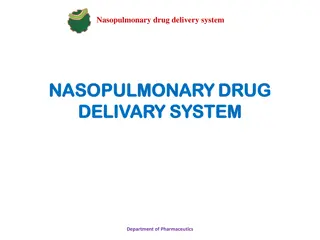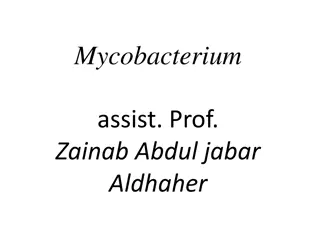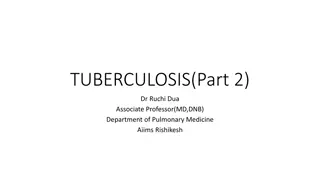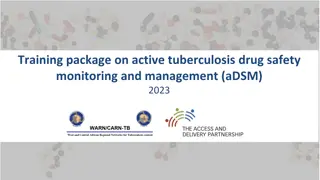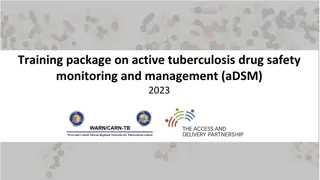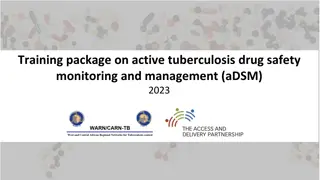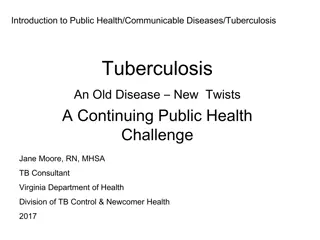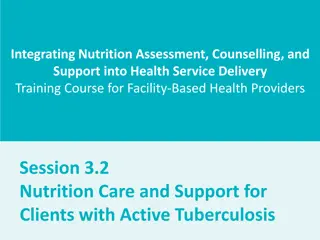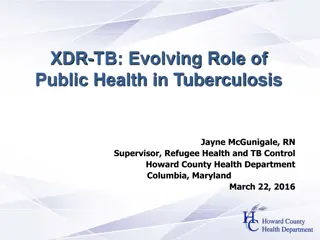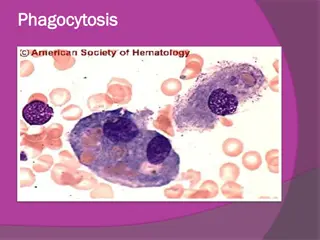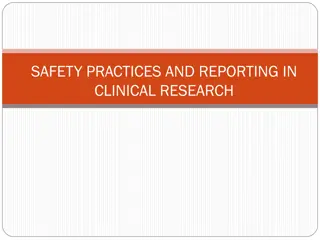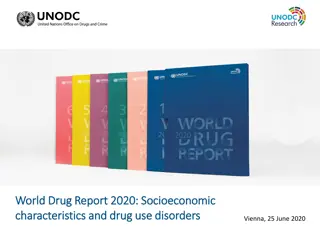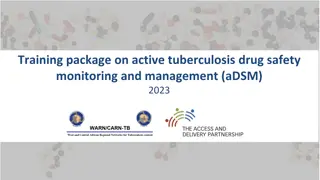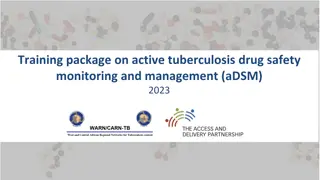Active Tuberculosis Drug Safety Monitoring & Management Roles
This presentation outlines roles & responsibilities in the management & coordination of active tuberculosis drug safety monitoring at different levels - Health facility, National, and Global. It covers key steps in implementation, defining roles, learning objectives, overview, and detailed roles and responsibilities at different levels.
Download Presentation

Please find below an Image/Link to download the presentation.
The content on the website is provided AS IS for your information and personal use only. It may not be sold, licensed, or shared on other websites without obtaining consent from the author.If you encounter any issues during the download, it is possible that the publisher has removed the file from their server.
You are allowed to download the files provided on this website for personal or commercial use, subject to the condition that they are used lawfully. All files are the property of their respective owners.
The content on the website is provided AS IS for your information and personal use only. It may not be sold, licensed, or shared on other websites without obtaining consent from the author.
E N D
Presentation Transcript
Training package on active tuberculosis drug safety monitoring and management (aDSM) 2023
2.1iii. Define management and supervision roles and responsibilities
Key steps in aDSM implementation Create a national coordinating mechanism for aDSM Develop a plan for aDSM Define management and supervision roles and responsibilities Create standard data collection materials Train staff on the collection of data Define schedules and routes for data collection and reporting Consolidate aDSM data electronically Develop capacity for signal detection and causality assessment
Learning objective By the end of this presentation, the participant is expected to be able to: Describe the roles and responsibilities in the management and coordination of aDSM at the Health facility level National level Global level
Overview of roles and responsibilities Health facility level National level Global level Main activities Detection, management and record AE Initiation and implementation of aDSM activities Maintain a global database of PV Detect signals and inform future global policy updates on TB drug use and new regimens Coordination of the mechanism and development of SOP Actors Clinicians, nurses, community health workers NTP and the pharmacovigilance structure (PV) WHO
Roles and responsibilities Health facility level (1) Main activities are the Detection of adverse events (AEs) Management of AEs Recording of AEs Transfer of data on AEs to the next administrative level e.g. regional or national level
Roles and responsibilities Health facility level (2) Several staff positions or entities (Clinicians, nurses, community health workers) have different responsibilities with respect to aDSM: conduct clinical monitoring early detection and management of adverse events (AEs) collect aDSM data during baseline, treatment initiation and subsequent clinical visits record AEs Clinical Experts on MDR-TB management Advise the treating clinicians on potential relationships between the drug or regimen and the AE
Roles and responsibilities Health facility level (3) Data entry staff Check completeness and consistency of data collected Notify the clinical expert team of any problems with the quality, completeness or timeliness of the aDSM data collected Submitting entered data to the national aDSM database at regular intervals, according to national regulations Data manager Data storage and quality Timely data transfer to the national level Regular feedback to the clinicians collecting aDSM data
Roles and responsibilities National level (1) The main agencies involved in aDSM at national level are: the national TB programme (NTP) and the pharmacovigilance structure (NPV) The tasks in aDSM are divided between them according to local regulations The NPV can provide guidance to the NTP on aDSM activities If a NPV does not exist, one or more staff from other disease programs (e.g. HIV or malaria) who have the right expertise could advise the NTP on aDSM activities The NTP is usually the initiator of aDSM activities for the TB programme
Roles and responsibilities National level (2) The national TB programme organizing a national aDSM coordinating mechanism (see Module 2.1i) secures funding for the implementation of different elements of aDSM develops Standard Operating Procedures (SOPs) ensures all staff involved in aDSM receives appropriate training
Roles and responsibilities National level (3) The national TB programme ensures that paper or electronic means to consolidate the aDSM data are available newly created or modified existing system, and functioning adequately at the start of aDSM activities Can be adapted for health facilities Collecting data according to the plan Managing and supervising all aspects of aDSM data collection Reporting validated data to supranational level
Roles and responsibilities National level (4) The national TB programme, possibly with NPV Assesses causality Signal detection Data analysis and provision of feedback to health centers and clinicians Communication of new knowledge to health care professionals and public (see Module 3.2)
Roles and responsibilities Global level WHO maintain a global PV database This database will accommodate SAEs and other AEs for TB patients on aDSM The global aDSM database will be used to help detect signals and inform future updates of global policies on the use of anti-TB drugs and novel regimens This process is distinct from the existing mechanism for the global coordination of individual case safety reports (spontaneous reports) from NPVs
Conclusions Roles and responsibilities for aDSM are discussed at three main levels: health facility, national and global The health facility needs to be equipped to monitor patients and manage AEs At national level the roles and responsibilities are split between NTP and the pharmacovigilance structure The global level is dealing with the global aDSM reports, signal detection, acquisition and use of new knowledge for policy updates
Acknowledgements The development of the aDSM training material was funded by TDR as part of the Access and Delivery Partnership (ADP) with funding from the Government of Japan. These training materials were put together in 2016 the WHO Task Force on aDSM with technical partners KNCV Tuberculosis Foundation, Management Sciences for Health (SIAPS), MSF, WHO GTB, and TDR. The materials were updated in 2022-23 by Mahamadou Bassirou Souleymane (TDR consultant) with Marie-Eve Raguenaud (TDR), Branwen J Hennig (TDR), and Corinne Merle (TDR), and reviewed by Linh Nhat Nguyen (WHO/GTB), Medea Gegia (WHO/GTB), and Fuad Mirzayev (WHO/GTB). We thank all members of the WARN/CARN-TB working group on aDSM who contributed to the development of the aDSM generic guidelines as well as the secretariat, particularly Dr Christ Houessinon: Disadidi Ambrioso, Esse Marius, Adomou Jamal Rouamba Ruffine, Haro Sougrimani, Koumbem Boureima, Nsanzerugeze Jos lyne, Tollo Tollo Daniel Alphonse D sir , Mpaba Minkat Th ophile Mistral, Julie Abessolo, Ursule IDOKO, Tijan Baldeh , Wandifa Samateh, Tida S Kinteh, Alieu Wurie, Mardemn Yeasuen, Benjamin K. Quenneh, Cheick Oumar Bah, Kane El Hadj Malick, Aw Idriss, Mamoudou Hama Rachida, Gagara I. M. Assiatou, Katamb Balkissa, Seiyabatou ElhSaidou, Liombo Anastasie, Lunganyu Junior, Kitambala Sentime, Lula Yves , Habimana-Mucyo Yves, Migambi Patrick, dos Santos Brigite, Castro V nia, Wadson Cruz, Gueye Aminata, Mukeh Fahnbulleh, Bailor Samuel, Manjo Lamin, Saleh Mahareb Abdoulaye, Haroun Saleh Naima, Mouhoudine Yerima, Kpelafia Silifa


